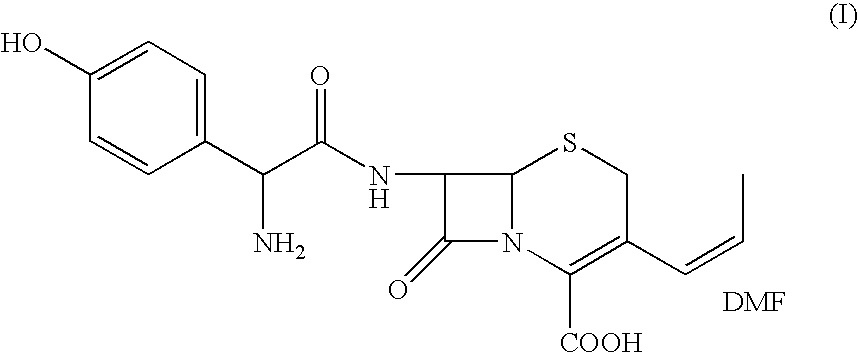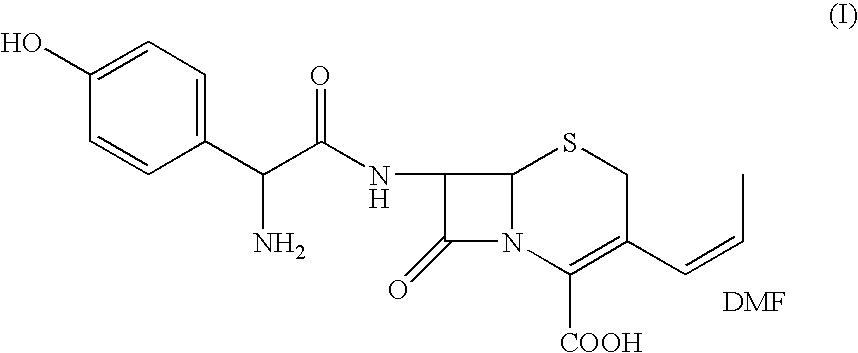Process for the preparation of 3-propenyl cephalosporin DMF solvate
a technology of cephalosporin and dmf, which is applied in the field of improvement, can solve the problems of inability to achieve high isomeric purity, low yield in the process, and inability to easily achieve industrial scale operation, etc., and achieves high purity and yield. , the effect of easy operation on industrial scal
- Summary
- Abstract
- Description
- Claims
- Application Information
AI Technical Summary
Benefits of technology
Problems solved by technology
Method used
Image
Examples
example 1
Step (i)
[0050]Preparation of 4-methoxybenzyl 7-phenylacetamido-3-[(triphenylphosporanylidene) methyl]-3-cephem-4-carboxylate (VIII) To a suspension of 4-methoxybenzyl 7-phenylacetamido-3-chloromethyl-3-cephem-4-carboxylate (VII) (100 g, 0.2053 mol) in methylene chloride (600 ml), NaI (32.3 g, 0.2155 mol), triphenylphosphine (56.6 g, 0.2157 mol) and water (600 ml) were added. The mixture was stirred at 32 to 35° C. under nitrogen atmosphere for 90 min. The organic layer was separated and IN NaOH (217 ml) was added. The resulting reddish brown mixture was stirred at 30 to 32° C. for 20 min. The organic layer was separated and washed with water (500 ml) followed by 20% w / w aq. NaCl solution (500 ml). The organic layer was diluted upto 1000 ml using fresh methylene chloride. The title compound (VIII) in methylene chloride used as such in the next reaction.
Step (ii)
Preparation of 4-methoxybenzyl 7-phenylacetamido-3-[(Z / E)-propen-1y1]-3-cephem-4-carboxylate (IX)
[0051]To a cold suspension ...
example 2
Step (i)
Preparation of 4-methoxybenzyl 7-phenylacetamido-3-[(triphenylphosporanylidene)methyl]-3-cephem-4-carboxylate (VIII)
[0059]To a stirred suspension of 4-methoxybenzyl 7-phenylacetamido-3-chloromethyl-3-cephem-4-carboxylate (VII) (10 g, 0.0205 mol) in acetone (50 ml), sodium iodide (3.1 g, 0.0207 mol) and triphenylphosphine (5.9 g, 0.0226 mol) were added. The mixture was stirred at 30 to 32° C. for 1.5 hrs. The resulting mixture was concentrated in vacuo to get the residual oil. To this concentrate methylene chloride (50 ml) was added and to the resultant solution, 2N NaOH solution (20 ml) was added and stirred at 30 to 32° C. for 20 min. The organic layer was separated and washed with water (25 ml) and dried over anhydrous sodium sulfate to give the title compound (VIII) in methylene chloride.
Step (ii)
Preparation of 4-methoxybenzyl 7-phenylacetamido-3-[(Z / E)-propen-1-yl]-3-cephem-4-carboxylate (IX)
[0060]To a cold suspension of lithium chloride (26.2 g, 0.6179 mol) in dry DMF (...
example 3
Step (i)
Preparation of 4-methoxybenzyl 7-phenylacetamido-3-[(triphenylphosporanylidene) methyl]-3-cephem-4-carboxylate (VIII)
[0067]To a suspension of 4-methoxybenzyl 7-phenylacetamido-3-chloromethyl-3-cephem-4-carboxylate (VII) (100 g, 0.2053 mol) in methylene chloride (600 ml), NaI (32.3 g, 0.2155 mol), triphenylphosphine (56.6 g, 0.2155 mol) and water (600 ml) were added. The mixture was stirred at 32 to 35° C. under nitrogen atmosphere for 90 min. The organic layer was separated and 1N NaOH (217 ml) was added. The resulting reddish brown mixture was stirred at 30 to 32° C. for 20 min. The organic layer was separated and washed with water (500 ml) followed by 20% w / w aq. NaCl solution (500 ml). The organic layer was diluted upto 1000 ml using fresh methylene chloride. The title compound (VIII) in methylene chloride used as such in the next reaction.
Step (ii)
Preparation of 4-methoxybenzyl 7-phenylacetamido-3-[(Z / E)-propen-1-yl]-3-cephem-4-carboxylate (IX)
[0068]To a cold solution of...
PUM
| Property | Measurement | Unit |
|---|---|---|
| temperature | aaaaa | aaaaa |
| temperature | aaaaa | aaaaa |
| temperature | aaaaa | aaaaa |
Abstract
Description
Claims
Application Information
 Login to View More
Login to View More - R&D
- Intellectual Property
- Life Sciences
- Materials
- Tech Scout
- Unparalleled Data Quality
- Higher Quality Content
- 60% Fewer Hallucinations
Browse by: Latest US Patents, China's latest patents, Technical Efficacy Thesaurus, Application Domain, Technology Topic, Popular Technical Reports.
© 2025 PatSnap. All rights reserved.Legal|Privacy policy|Modern Slavery Act Transparency Statement|Sitemap|About US| Contact US: help@patsnap.com



